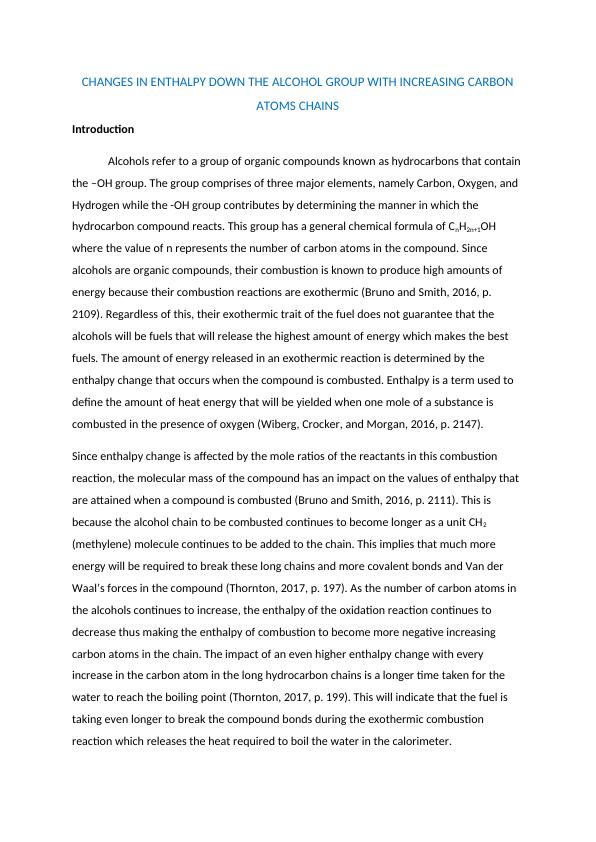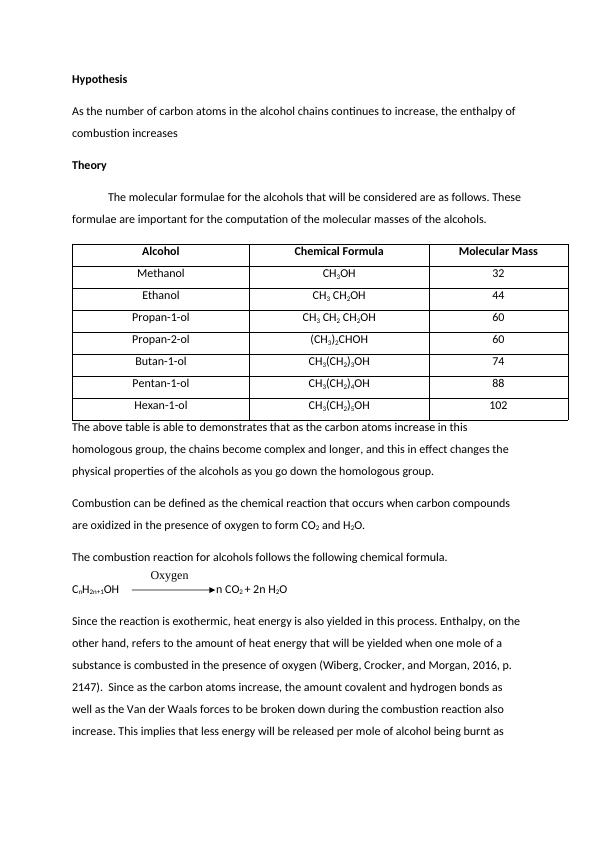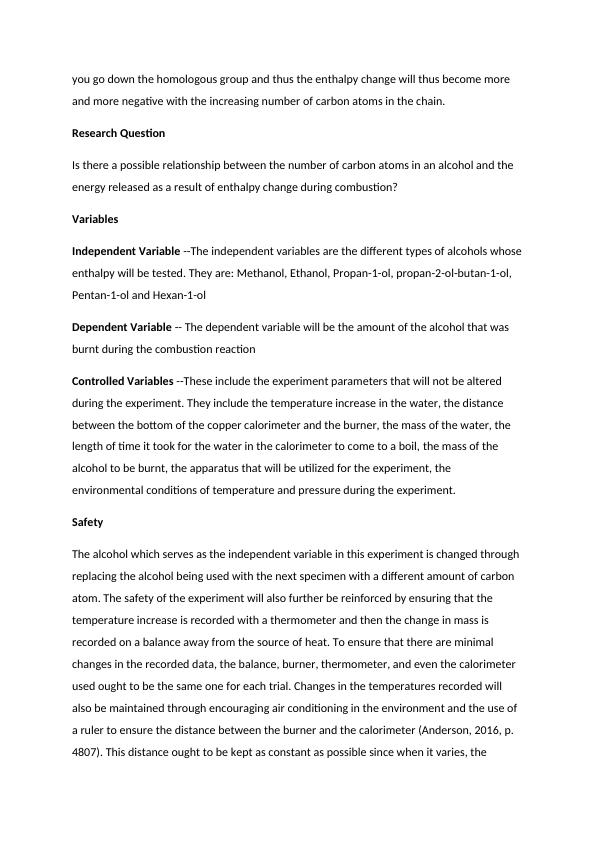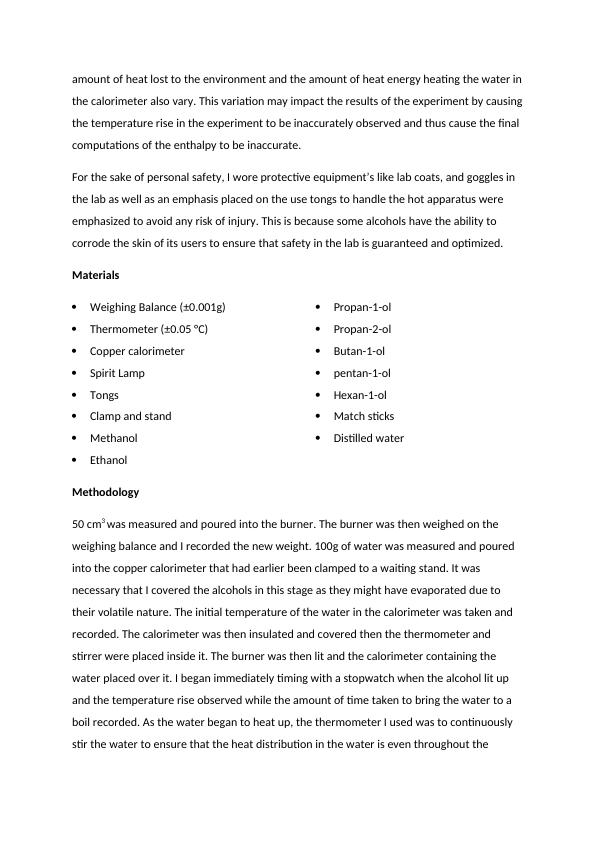CHANGES IN ENTHALPY DOWN THE ALCOHOL GROUP WITH INCREASING CARBON ATOMS CHAINS Introduction Alcohols
Investigating the changes in enthalpy down the alcohol group with increasing carbon atoms chains.
13 Pages3734 Words80 Views
Added on 2023-04-24
CHANGES IN ENTHALPY DOWN THE ALCOHOL GROUP WITH INCREASING CARBON ATOMS CHAINS Introduction Alcohols
Investigating the changes in enthalpy down the alcohol group with increasing carbon atoms chains.
Added on 2023-04-24
ShareRelated Documents
CHANGES IN ENTHALPY DOWN THE ALCOHOL GROUP WITH INCREASING CARBON
ATOMS CHAINS
Introduction
Alcohols refer to a group of organic compounds known as hydrocarbons that contain
the –OH group. The group comprises of three major elements, namely Carbon, Oxygen, and
Hydrogen while the -OH group contributes by determining the manner in which the
hydrocarbon compound reacts. This group has a general chemical formula of CnH2n+1OH
where the value of n represents the number of carbon atoms in the compound. Since
alcohols are organic compounds, their combustion is known to produce high amounts of
energy because their combustion reactions are exothermic (Bruno and Smith, 2016, p.
2109). Regardless of this, their exothermic trait of the fuel does not guarantee that the
alcohols will be fuels that will release the highest amount of energy which makes the best
fuels. The amount of energy released in an exothermic reaction is determined by the
enthalpy change that occurs when the compound is combusted. Enthalpy is a term used to
define the amount of heat energy that will be yielded when one mole of a substance is
combusted in the presence of oxygen (Wiberg, Crocker, and Morgan, 2016, p. 2147).
Since enthalpy change is affected by the mole ratios of the reactants in this combustion
reaction, the molecular mass of the compound has an impact on the values of enthalpy that
are attained when a compound is combusted (Bruno and Smith, 2016, p. 2111). This is
because the alcohol chain to be combusted continues to become longer as a unit CH2
(methylene) molecule continues to be added to the chain. This implies that much more
energy will be required to break these long chains and more covalent bonds and Van der
Waal’s forces in the compound (Thornton, 2017, p. 197). As the number of carbon atoms in
the alcohols continues to increase, the enthalpy of the oxidation reaction continues to
decrease thus making the enthalpy of combustion to become more negative increasing
carbon atoms in the chain. The impact of an even higher enthalpy change with every
increase in the carbon atom in the long hydrocarbon chains is a longer time taken for the
water to reach the boiling point (Thornton, 2017, p. 199). This will indicate that the fuel is
taking even longer to break the compound bonds during the exothermic combustion
reaction which releases the heat required to boil the water in the calorimeter.
ATOMS CHAINS
Introduction
Alcohols refer to a group of organic compounds known as hydrocarbons that contain
the –OH group. The group comprises of three major elements, namely Carbon, Oxygen, and
Hydrogen while the -OH group contributes by determining the manner in which the
hydrocarbon compound reacts. This group has a general chemical formula of CnH2n+1OH
where the value of n represents the number of carbon atoms in the compound. Since
alcohols are organic compounds, their combustion is known to produce high amounts of
energy because their combustion reactions are exothermic (Bruno and Smith, 2016, p.
2109). Regardless of this, their exothermic trait of the fuel does not guarantee that the
alcohols will be fuels that will release the highest amount of energy which makes the best
fuels. The amount of energy released in an exothermic reaction is determined by the
enthalpy change that occurs when the compound is combusted. Enthalpy is a term used to
define the amount of heat energy that will be yielded when one mole of a substance is
combusted in the presence of oxygen (Wiberg, Crocker, and Morgan, 2016, p. 2147).
Since enthalpy change is affected by the mole ratios of the reactants in this combustion
reaction, the molecular mass of the compound has an impact on the values of enthalpy that
are attained when a compound is combusted (Bruno and Smith, 2016, p. 2111). This is
because the alcohol chain to be combusted continues to become longer as a unit CH2
(methylene) molecule continues to be added to the chain. This implies that much more
energy will be required to break these long chains and more covalent bonds and Van der
Waal’s forces in the compound (Thornton, 2017, p. 197). As the number of carbon atoms in
the alcohols continues to increase, the enthalpy of the oxidation reaction continues to
decrease thus making the enthalpy of combustion to become more negative increasing
carbon atoms in the chain. The impact of an even higher enthalpy change with every
increase in the carbon atom in the long hydrocarbon chains is a longer time taken for the
water to reach the boiling point (Thornton, 2017, p. 199). This will indicate that the fuel is
taking even longer to break the compound bonds during the exothermic combustion
reaction which releases the heat required to boil the water in the calorimeter.

Hypothesis
As the number of carbon atoms in the alcohol chains continues to increase, the enthalpy of
combustion increases
Theory
The molecular formulae for the alcohols that will be considered are as follows. These
formulae are important for the computation of the molecular masses of the alcohols.
Alcohol Chemical Formula Molecular Mass
Methanol CH3OH 32
Ethanol CH3 CH2OH 44
Propan-1-ol CH3 CH2 CH2OH 60
Propan-2-ol (CH3)2CHOH 60
Butan-1-ol CH3(CH2)3OH 74
Pentan-1-ol CH3(CH2)4OH 88
Hexan-1-ol CH3(CH2)5OH 102
The above table is able to demonstrates that as the carbon atoms increase in this
homologous group, the chains become complex and longer, and this in effect changes the
physical properties of the alcohols as you go down the homologous group.
Combustion can be defined as the chemical reaction that occurs when carbon compounds
are oxidized in the presence of oxygen to form CO2 and H2O.
The combustion reaction for alcohols follows the following chemical formula.
CnH2n+1OH n CO2 + 2n H2O
Since the reaction is exothermic, heat energy is also yielded in this process. Enthalpy, on the
other hand, refers to the amount of heat energy that will be yielded when one mole of a
substance is combusted in the presence of oxygen (Wiberg, Crocker, and Morgan, 2016, p.
2147). Since as the carbon atoms increase, the amount covalent and hydrogen bonds as
well as the Van der Waals forces to be broken down during the combustion reaction also
increase. This implies that less energy will be released per mole of alcohol being burnt as
Oxygen
As the number of carbon atoms in the alcohol chains continues to increase, the enthalpy of
combustion increases
Theory
The molecular formulae for the alcohols that will be considered are as follows. These
formulae are important for the computation of the molecular masses of the alcohols.
Alcohol Chemical Formula Molecular Mass
Methanol CH3OH 32
Ethanol CH3 CH2OH 44
Propan-1-ol CH3 CH2 CH2OH 60
Propan-2-ol (CH3)2CHOH 60
Butan-1-ol CH3(CH2)3OH 74
Pentan-1-ol CH3(CH2)4OH 88
Hexan-1-ol CH3(CH2)5OH 102
The above table is able to demonstrates that as the carbon atoms increase in this
homologous group, the chains become complex and longer, and this in effect changes the
physical properties of the alcohols as you go down the homologous group.
Combustion can be defined as the chemical reaction that occurs when carbon compounds
are oxidized in the presence of oxygen to form CO2 and H2O.
The combustion reaction for alcohols follows the following chemical formula.
CnH2n+1OH n CO2 + 2n H2O
Since the reaction is exothermic, heat energy is also yielded in this process. Enthalpy, on the
other hand, refers to the amount of heat energy that will be yielded when one mole of a
substance is combusted in the presence of oxygen (Wiberg, Crocker, and Morgan, 2016, p.
2147). Since as the carbon atoms increase, the amount covalent and hydrogen bonds as
well as the Van der Waals forces to be broken down during the combustion reaction also
increase. This implies that less energy will be released per mole of alcohol being burnt as
Oxygen

you go down the homologous group and thus the enthalpy change will thus become more
and more negative with the increasing number of carbon atoms in the chain.
Research Question
Is there a possible relationship between the number of carbon atoms in an alcohol and the
energy released as a result of enthalpy change during combustion?
Variables
Independent Variable --The independent variables are the different types of alcohols whose
enthalpy will be tested. They are: Methanol, Ethanol, Propan-1-ol, propan-2-ol-butan-1-ol,
Pentan-1-ol and Hexan-1-ol
Dependent Variable -- The dependent variable will be the amount of the alcohol that was
burnt during the combustion reaction
Controlled Variables --These include the experiment parameters that will not be altered
during the experiment. They include the temperature increase in the water, the distance
between the bottom of the copper calorimeter and the burner, the mass of the water, the
length of time it took for the water in the calorimeter to come to a boil, the mass of the
alcohol to be burnt, the apparatus that will be utilized for the experiment, the
environmental conditions of temperature and pressure during the experiment.
Safety
The alcohol which serves as the independent variable in this experiment is changed through
replacing the alcohol being used with the next specimen with a different amount of carbon
atom. The safety of the experiment will also further be reinforced by ensuring that the
temperature increase is recorded with a thermometer and then the change in mass is
recorded on a balance away from the source of heat. To ensure that there are minimal
changes in the recorded data, the balance, burner, thermometer, and even the calorimeter
used ought to be the same one for each trial. Changes in the temperatures recorded will
also be maintained through encouraging air conditioning in the environment and the use of
a ruler to ensure the distance between the burner and the calorimeter (Anderson, 2016, p.
4807). This distance ought to be kept as constant as possible since when it varies, the
and more negative with the increasing number of carbon atoms in the chain.
Research Question
Is there a possible relationship between the number of carbon atoms in an alcohol and the
energy released as a result of enthalpy change during combustion?
Variables
Independent Variable --The independent variables are the different types of alcohols whose
enthalpy will be tested. They are: Methanol, Ethanol, Propan-1-ol, propan-2-ol-butan-1-ol,
Pentan-1-ol and Hexan-1-ol
Dependent Variable -- The dependent variable will be the amount of the alcohol that was
burnt during the combustion reaction
Controlled Variables --These include the experiment parameters that will not be altered
during the experiment. They include the temperature increase in the water, the distance
between the bottom of the copper calorimeter and the burner, the mass of the water, the
length of time it took for the water in the calorimeter to come to a boil, the mass of the
alcohol to be burnt, the apparatus that will be utilized for the experiment, the
environmental conditions of temperature and pressure during the experiment.
Safety
The alcohol which serves as the independent variable in this experiment is changed through
replacing the alcohol being used with the next specimen with a different amount of carbon
atom. The safety of the experiment will also further be reinforced by ensuring that the
temperature increase is recorded with a thermometer and then the change in mass is
recorded on a balance away from the source of heat. To ensure that there are minimal
changes in the recorded data, the balance, burner, thermometer, and even the calorimeter
used ought to be the same one for each trial. Changes in the temperatures recorded will
also be maintained through encouraging air conditioning in the environment and the use of
a ruler to ensure the distance between the burner and the calorimeter (Anderson, 2016, p.
4807). This distance ought to be kept as constant as possible since when it varies, the

amount of heat lost to the environment and the amount of heat energy heating the water in
the calorimeter also vary. This variation may impact the results of the experiment by causing
the temperature rise in the experiment to be inaccurately observed and thus cause the final
computations of the enthalpy to be inaccurate.
For the sake of personal safety, I wore protective equipment’s like lab coats, and goggles in
the lab as well as an emphasis placed on the use tongs to handle the hot apparatus were
emphasized to avoid any risk of injury. This is because some alcohols have the ability to
corrode the skin of its users to ensure that safety in the lab is guaranteed and optimized.
Materials
Weighing Balance (±0.001g)
Thermometer (±0.05 °C)
Copper calorimeter
Spirit Lamp
Tongs
Clamp and stand
Methanol
Ethanol
Propan-1-ol
Propan-2-ol
Butan-1-ol
pentan-1-ol
Hexan-1-ol
Match sticks
Distilled water
Methodology
50 cm3 was measured and poured into the burner. The burner was then weighed on the
weighing balance and I recorded the new weight. 100g of water was measured and poured
into the copper calorimeter that had earlier been clamped to a waiting stand. It was
necessary that I covered the alcohols in this stage as they might have evaporated due to
their volatile nature. The initial temperature of the water in the calorimeter was taken and
recorded. The calorimeter was then insulated and covered then the thermometer and
stirrer were placed inside it. The burner was then lit and the calorimeter containing the
water placed over it. I began immediately timing with a stopwatch when the alcohol lit up
and the temperature rise observed while the amount of time taken to bring the water to a
boil recorded. As the water began to heat up, the thermometer I used was to continuously
stir the water to ensure that the heat distribution in the water is even throughout the
the calorimeter also vary. This variation may impact the results of the experiment by causing
the temperature rise in the experiment to be inaccurately observed and thus cause the final
computations of the enthalpy to be inaccurate.
For the sake of personal safety, I wore protective equipment’s like lab coats, and goggles in
the lab as well as an emphasis placed on the use tongs to handle the hot apparatus were
emphasized to avoid any risk of injury. This is because some alcohols have the ability to
corrode the skin of its users to ensure that safety in the lab is guaranteed and optimized.
Materials
Weighing Balance (±0.001g)
Thermometer (±0.05 °C)
Copper calorimeter
Spirit Lamp
Tongs
Clamp and stand
Methanol
Ethanol
Propan-1-ol
Propan-2-ol
Butan-1-ol
pentan-1-ol
Hexan-1-ol
Match sticks
Distilled water
Methodology
50 cm3 was measured and poured into the burner. The burner was then weighed on the
weighing balance and I recorded the new weight. 100g of water was measured and poured
into the copper calorimeter that had earlier been clamped to a waiting stand. It was
necessary that I covered the alcohols in this stage as they might have evaporated due to
their volatile nature. The initial temperature of the water in the calorimeter was taken and
recorded. The calorimeter was then insulated and covered then the thermometer and
stirrer were placed inside it. The burner was then lit and the calorimeter containing the
water placed over it. I began immediately timing with a stopwatch when the alcohol lit up
and the temperature rise observed while the amount of time taken to bring the water to a
boil recorded. As the water began to heat up, the thermometer I used was to continuously
stir the water to ensure that the heat distribution in the water is even throughout the

End of preview
Want to access all the pages? Upload your documents or become a member.
Related Documents
Enthalpy of Combustion in Different Alcohol Chains and Brancheslg...
|14
|3827
|499
The Role of Hydrocarbons Assignmentlg...
|9
|1681
|37
